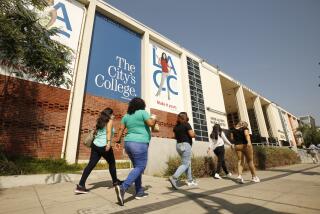Letters: Community colleges -- in a fix, but fixable
Re “Community colleges fall on hard times,” Sept. 23
Community colleges are to education what the wheel is to civilization: indispensable.
In the beginning, community colleges offered three paths to work readiness: two years of college preparation and a transition to a university; two-year certificated training that led to jobs, such as vocational nursing; and combination work-study programs leading to professional licenses, including registered nursing. Hospitals, corporations and entire industries benefited from the training provided by our community colleges.
Cost to the student? Almost free in the beginning. California residents over the age of 18 could attend these colleges. Millions of students benefited from this system; millions of consumers benefited from these well-trained students.
It’s time for profit-making beneficiaries to take on the cost of maintaining our community colleges. Let the oil companies and insurance companies and aircraft factories underwrite the cost of these schools.
Esther Cole
Ventura
The community college situation gets tricky as the traditional enrollment increase during an economic downturn has gotten crushed by the state’s budget woes. California’s 2.4 million community college students are a state unto themselves.
The state’s economic mismanagement, complete with upcoming pass-me-or-else propositions, is an albatross around the neck. Additionally, funding is intertwined with K-12 education, and community colleges get pushed to the bottom (see 2008’s failed Proposition 92).
The biggest deficiency in the system is its inability to use the brainpower and helpfulness of the people at the individual schools in crafting solutions. Figure out a way to harness them and the system will thrive.
Mason Malugeon
Huntington Beach
According to the article, 85% of community college students need remedial work in English, and 73% need remedial math. This is a reflection of the failure of California’s K-12 schools.
Standardized tests should indicate a student’s progress in math and English over time and should be used to evaluate teachers and students. Any system that uses test scores to evaluate teachers should also include a way to asses student motivation (which is partly determined by a teacher) and improvement over prior years’ results.
Overlooking the K-12 system is terribly shortsighted.
Frank E. Drsata
Huntington Beach
ALSO:
Letters: A veteran’s take on his healthcare
Letters: The myth of Obama’s inexperience
Postscript: A picture-perfect moment over L.A.
More to Read
A cure for the common opinion
Get thought-provoking perspectives with our weekly newsletter.
You may occasionally receive promotional content from the Los Angeles Times.










